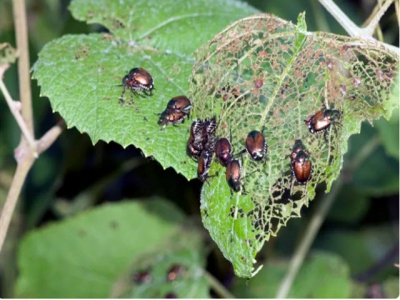The Japanese Beetles Are Back

Back without popular demand: Here comes the annual showing of Japanese beetles, the embodiment of beauty and the beast rolled into one.
Japanese beetle eat trees in Illinois. Photo: NYT
The 4-6-week period of intense activity by the gleaming, copper-colored adult Popillia japonica is underway.
These beetles may seem to have it in specifically for your roses, raspberries, crab apples or grapes, but those are just a few of the 300-plus plant species they are known to feed on in North America.
The expert advice might sound counterintuitive: Stop trapping them. (Farewell, beetle bags, despite the marketing promises.) And maybe hold back on watering lawns in the July heat, as female beetles will be seeking a moist spot to lay eggs.
Yes, those are steps toward making peace with this here-to-stay invasive pest, which scientists have sought to subdue since shortly after it was identified in New Jersey in 1916.
Nearly a century later, a 2015 U.S. Department of Agriculture homeowners’ guide to Japanese beetle management put the cost of control in the United States — including the removal and replacement of damaged turf — at $460 million annually. Half of that damage is caused not by the adults, but during the beetles’ larval stage, by the grubs.
Still, this is a troublemaker at both stages of life — and its wide-ranging diet doesn’t hurt its chances, either.
Based on decades of tracking the beetles’ seemingly inexorable march westward in North America, Daniel A. Potter, a professor in the department of entomology at University of Kentucky, described the arc: “The first few decades in a new area, the insect goes crazy and builds to high levels before the population starts to stabilize. Then it goes from a plague to a nuisance.”
For those of us at the nuisance phase, here are some suggestions. But first, some background on the strategies behind the Japanese beetle’s sustained invasion.
Có thể bạn quan tâm
 Trademark registration for agricultural products to heighten brand reputation
Trademark registration for agricultural products to heighten brand reputation Trademark plays an important role in the economy. In recent years, Binh Duong province has developed many agricultural collective trademarks
 Vietnamese rice makes name in world market
Vietnamese rice makes name in world market In 2018, Vietnam’s total rice exports reached 6.15 million tonnes, with an export turnover of 3.15 billion USD. The industry saw a 5.7% increase in volume
 Nam Định: Biosafety in frog farming
Nam Định: Biosafety in frog farming Farmers in Hải Ninh commune, Hải Hậu district, Nam Định provinces have been instructed to change 50 ha rice paddy field into aquaculture with Thailand frog farm
 Tea sector urged to improve product quality amid growing supply source
Tea sector urged to improve product quality amid growing supply source The Vietnamese tea sector must improve its competitive edge and product quality if it is to see an increase in value amid lower global demand and growing supply
 Central province approves hi-tech farms
Central province approves hi-tech farms The central province of Quảng Nam has approved hi-tech farming and agriculture park projects in Thăng Bình District and the township of Điện Bàn on 425 hectares